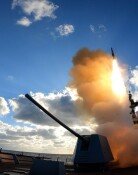What S. Korea has done while N.K. succeeded in ICBM engine test?
What S. Korea has done while N.K. succeeded in ICBM engine test?
Posted September. 21, 2016 07:26,
Updated September. 21, 2016 07:41
North Korea’s state media outlets reported on Tuesday, “A new high-output engine for rocket to transport a stationary satellite has achieved a phenomenal success in the ground thrust test.” If the North’s claim that the engine offers a combustion time of 200 seconds and the 80-ton force thrust power is true, Pyongyang is close to completing the development of an inter-continental ballistic missile (ICBM) engine. If four of the 80-ton engines are integrated through "clustering" technology, the North can send a nuclear warhead weighing 500–1,000 kilograms to anywhere in the mainland U.S. Chances are high that the North will launch a long-range missile around the October 10 anniversary of the founding of the North Korean Workers’ Party.
On North Korea’s announcement on its successful engine test, South Korea's Foreign Ministry said that the more provocations the North makes, the more and faster it will become isolated, but the statement sounds pointless and meaningless at best. The North has aggressively and speedily pushed for advancement of its nuclear and missile capabilities ranging from the fourth nuclear test in January to the rocket engine test this time, and achieved great strides. As Pyongyang also succeeded in miniaturizing, reducing, standardizing small nuclear warheads, and test firing of missiles including Rodong, Musudan and submarine-launched ballistic missiles, the only remaining task for the North is to conduct test firing of an ICBM. Just as North Korean leader Kim Jong Un confidently has told, not only South Korea but also Japan and the U.S. are now within the range of North Korean nuclear weapons.
We now have to ask what South Korea has done at all while the North has materialized the development of formidable nuclear weapons. The North’s new rocket engine offers a bigger thrust than the (South) Korean standard rocket that Seoul is developing with the aim of completing by 2020. South Korea only succeeded in test to have the engine combust for 145 seconds as recently as in July due to, among other reasons, difficulties in welding of the fuel tank, but nonetheless bragged about increasing the combustion time by merely two seconds than the original goal. What excuse can South Korean scientists make after claiming the supremacy of the South Korean standard rocket while downplaying the level of science in the North? Five reconnaissance satellites that the South Korean military is currently developing only provide a reconnaissance interval of two hours, and hence are not capable of detecting the moves in North Korea, which already reduced the time required for preparation to launch missiles to one hour. Even if the South develops "the Kill Chain," a preemptive strike system against the North that the South is developing with the aim of completing by 2020, the defense system is poised to become useless even before being deployed.
It has been made clear that while the North heavily invested its resources in the development of nuclear weapons and missiles to make a slew of successes, the South has not secured measures to effectively cope with the threat, and that the South is lagging behind even in the related field of science and technology as well. The grave reality of national security that the South is facing is a crisis situation wherein the country has no other options but to solely depend on the U.S. for its defense. People feel anxious because it is doubtful whether the South Korean government and military has capacity, commitment and measures to "block and retaliate for North Korean nuclear weapons."
한기흥기자 eligius@donga.com







